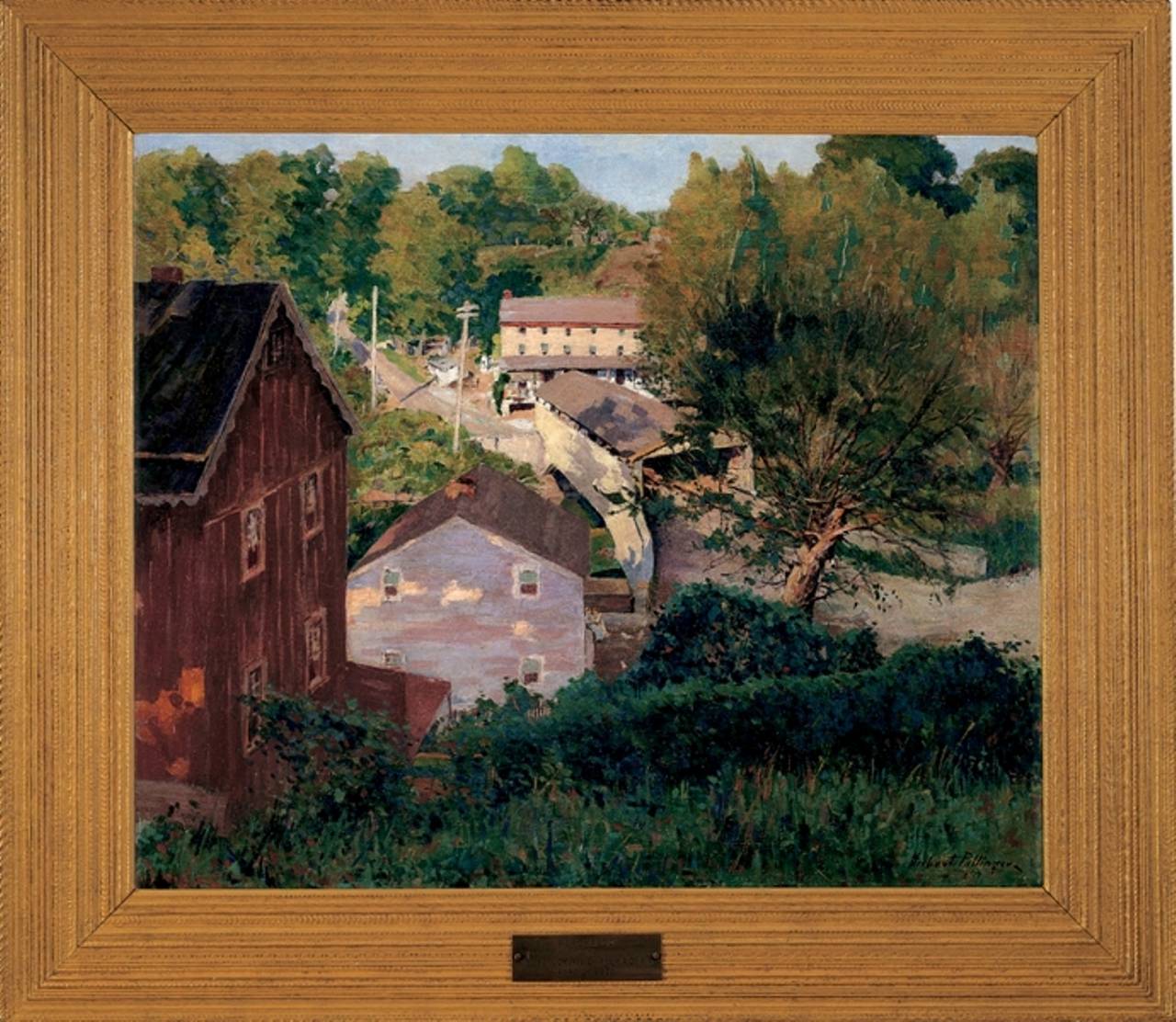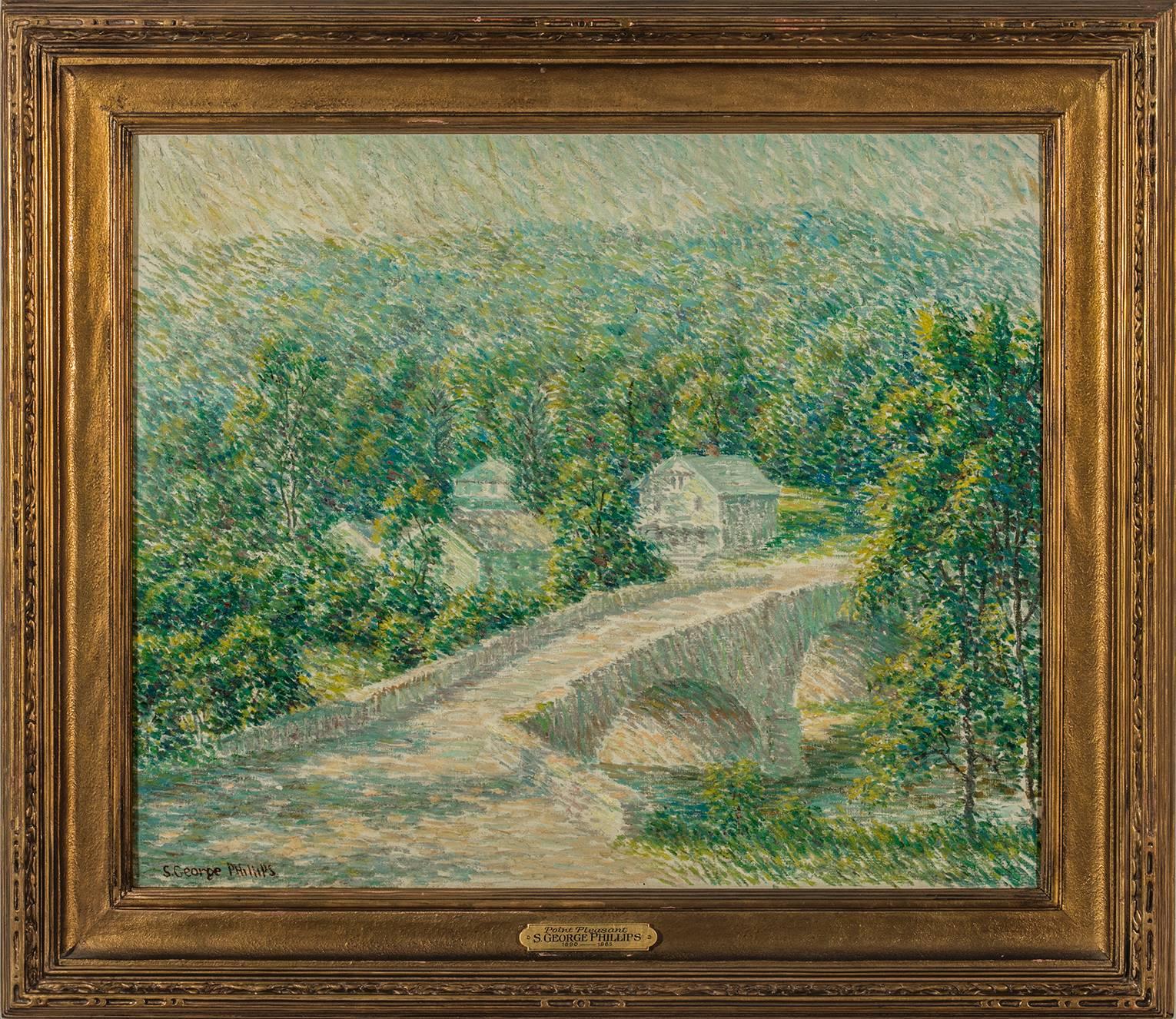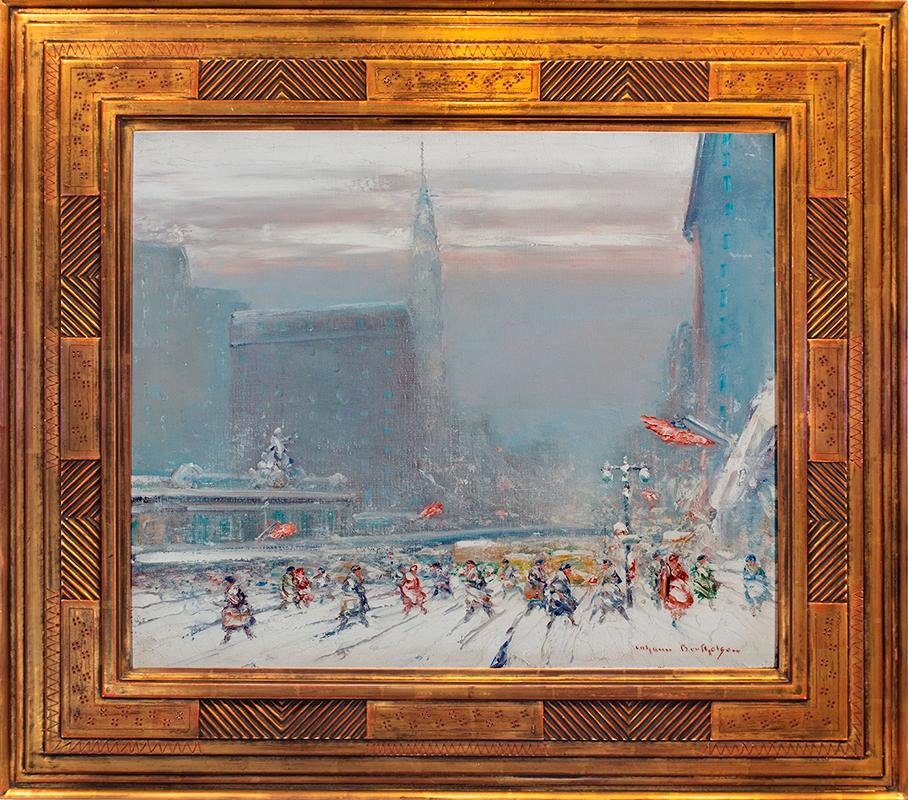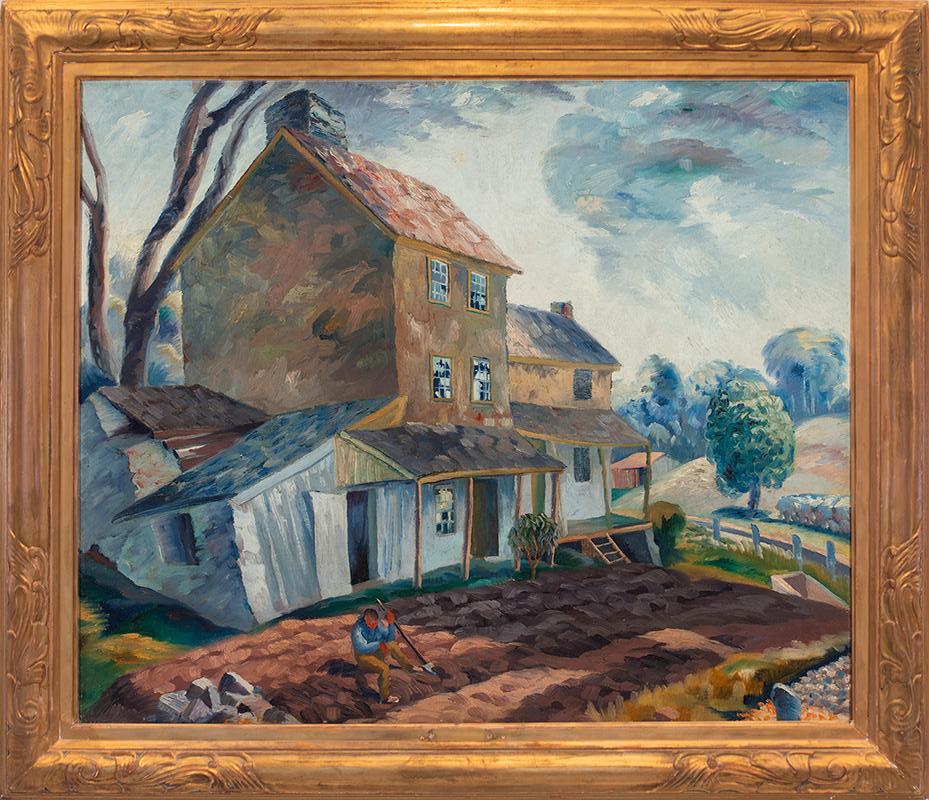Items Similar to Pont Neuf - Evening - 19th Century Oil, Riverscape at Night by A E Othon Friesz
Want more images or videos?
Request additional images or videos from the seller
1 of 9
Achille-Émile Othon FrieszPont Neuf - Evening - 19th Century Oil, Riverscape at Night by A E Othon Friesz1903
1903
About the Item
THIS WORK IS CURRENTLY ON LOAN TO THE MUSEUM OF MODERN ART IN LE HAVRE AND IS BEING EXHIBITED IN THEIR ELECTRIC NIGHTS EXHIBITION 2020
A stunning oil on original canvas by Achile-Emile Othon Friesz depicting a night time view of the Pont Neuf bridge over the Seine, Paris. The painting shows deep blues and reds - richer than those of traditional impressionist paintings - and shows the transition into Fauvism. Signed and dated 1903 lower right. Framed dimensions are 24.5 inches high by 20 inches wide.
Achille Friesz was the son of a family of sailors from Le Havre. From 1885 he often spent time in Marseilles visiting his maternal uncles. As a child he dreamed of going to sea, but from the age of 12 he developed a passion for art, and after secondary school he attended the École des Beaux-Arts in Le Havre. There, from 1896 to 1898, he studied under Charles-Marie Lhullier who had been a friend of Jongkind and whom, like Dufy and Braque, he remembered fondly throughout his life. Lhullier introduced his students to the work of Chardin, Corot, Géricault and Delacroix.
After receiving a bursary from the local authorities in 1898, he went to Paris and, while his friends Matisse, Rouault and Marquet studied under Gustave Moreau, enrolled at the École des Beaux-Arts at the studio of Léon Bonnat, where he was joined by Dufy. However, he scarcely attended the studio, preferring to go to the Louvre and make copies of the works of Clouet, Veronese, Rubens, Claude Lorraine and Delacroix. He did his military service in Paris in 1902 but continued with his art. Around this time he met Camille Pissarro and sought his advice.
As a young man he began to make frequent trips away, not necessarily travelling very far, but looking for subjects for his work, usually landscapes. Among the places he visited were the Creuse region around 1903, Antwerp in 1905, returning there with Braque in 1906, and La Ciotat, Cassis and L'Estaque in 1906-1907, again in the company of Braque. In Paris he frequently moved lodgings until 1914. He moved in with Henri Matisse at the Couvent des Oiseaux from 1905-1910, that is to say at the period when Fauvism was at its height. In 1908 he returned to his native Normandy to reimmerse himself in his early environment; he would return to the region throughout his life. He made a trip to Munich with Dufy in 1909, and visited Portugal in 1911-1912 and Belgium in 1912. In 1914 he was called up and assigned to technical services, not being demobilised until March 1919, although he did manage to maintain a certain independence. From 1914 until his death he lived in Paris at 73 Rue Notre-Dame-des-Champs, where he occupied Bouguereau's old studio. He made frequent trips to Cap-Brun near Toulon where, in 1923, he acquired a property called Les Jarres, as well as making numerous visits to Normandy and Le Havre.
In 1925 he received the highest commendation at the Carnegie Prize in Pittsburgh for Portrait of the Decorative Artist Paul Paquereau. Also in 1925, at the same time as Matisse, he was made a Chevalier of the Légion d'Honneur, rising to in Officier in 1933 and Commandeur in 1937. He was also made Commander of the Swedish order of Vasa in 1934. Throughout his life, Friesz was a teacher: from 1913 at the Académie Moderne; from 1929 at the Académie Scandinave; and from 1941 until his death at the Académie de la Grande-Chaumière.
Alongside his activity as a painter, he illustrated several works of literature, including: in 1920 Le Pacte de l'Écolier Juan by Jules Tellier; in 1924 Échelles de Soie by Jean Pédron; in 1926 Le Jardin sur l'Oronte by Maurice Barrès; in 1926 En Suivant la Seine by Gustave Coquiot; in 1929 Rouen by André Maurois; in 1931 The Song of Songs; in 1934 Poésies by Pierre de Ronsard; in 1945 Le Bouquet de la Mariée by Gabriel-Joseph Gros; in 1947 Paul et Virginie by Bernardin de St-Pierre; in 1949 Le Livre de Job by Pierre Poussard; in 1949 Petronius's Satyricon, and in 1949 a collection of 12 unpublished lithographs for Le Désert de l'Amour by François Mauriac. He also designed several pieces of decorative art: from 1906 to 1909 ceramics executed by Metthey among others; a façade for a private house in Le Havre; a china service for two for the Le Havre writer J.-G. Aubry; vases, dishes and plates; in 1912 four sets for La Lumière by Georges Duhamel, performed at the Odéon; in 1916 a screen for the Le Havre collector Léon Pédron; in 1918 panels for Pédron's dining room; in 1920 a mural entitled Children Dancing (Enfants Dansant); in 1920 Les Volières for the apartment of Vicomte Amédée de Flers; in 1935 Peace (La Paix), a Gobelins tapestry presented by France to the Palais des Nations in Geneva; in 1937 La Seine in collaboration with Dufy for the Palais de Chaillot, with each artist taking half of the river's course - From the Source to Paris by Friesz and From Paris to the Estuary by Dufy.
The Fauves were producing Fauve paintings before they knew it: it was not until the critic Louis Vauxcelles saw their work at the Salon des Indépendants in 1905 and mockingly used the word Fauve to describe it that the term was born. It is known that Vlaminck and Derain worked together and that the École de Chatou was composed of just these two artists. Friesz was living with Matisse and after his first trip to Antwerp in 1905, he returned in 1906 with Braque. In 1906-1907 Friesz and Braque went to La Ciotat to paint and there they met up with Matisse. The paintings Friesz produced in Antwerp are Fauve inasmuch as they are painted in pure colours and are more or less free of the divisionism of the Impressionists, although the draughtsmanship is fairly standard; these works include The Port, The Escaut, The Canals, The Dock with Sailing Ships and The Red Slipway. Those of Braque the following year, in particular Terrace on the Escaut, show great similarities with those Friesz painted of the same subject. Friesz was already avoiding the hardness of pure flat tints by graduating them in thin glazes, allowing the whiteness of the canvas to penetrate the transparency, a technique that came to characterise his entire Fauve period.
At La Ciotat Friesz and Braque adopted completely different Fauve styles, with Braque composing his paintings on horizontal and vertical orthogonals painted in small, regular, spaced-out touches, whereas Friesz developed his own personal rhythmical style of wide arabesques of colour in works such as The Bec-de-l'Aigle, Women Bathing and L'Estaque. Many of Friesz's Fauve works were produced in the south of France, and his Portrait of Fernand Fleuret also dates from this period.
When he returned to Normandy in 1908 the period that he described as his 'return to form' began; with compromise paintings such as Entrance to the Port of Honfleur, Côte de Grâce Landscape, The 'Bains Marie-Christine' in Le Havre and the great compositions characteristic of this period - Autumn Labours, Spring, Fisherman on a Rock and Women Bathing. His draughtsmanship retains something of the rhythm of the Fauve period, his figures following the lines of the landscape and the colour remaining clear and resonant. In 1909 he painted the Cirque Médrano series: The Trapeze Artist, The Clown and The Horsewoman. In the south of France he also painted the Olive Trees series. He made a trip to Munich with Raoul Dufy resulting in Winter in Munich. This was also the year of his first trip to Italy. Boat in a Rocky Inlet of 1910 marks one of the pivotal points between a totally rhythmic drawing style of sensual curves typical of his Fauve period and a reduced palette of muted ochres, browns and blues. From 1910 onwards, the final traces of Fauvism become less and less apparent in his work. His use of colour follows the same course, towards the transcription of reality, with broken tones, ochres and browns.
After his demobilisation, as well as in his studio in Paris, Friesz spent time in his house in Toulon, returned to Normandy and Le Havre and continued to make frequent, often local, forays in search of new subjects: in 1919 to Jura, producing the series Forests, Pine Trees, Road in the Snow and Invitation to Skate; in 1920 to Italy producing Piedmont Village, Florence Grape Pickers; in 1920 to Le Havre, producing The Étretat Cliffs, People Bathing at Étretat; in 1923 to his house in Toulon, producing View of Coudon, Women Bathing, Grape Harvesting, Jars; in 1924 he painted the Large Nude (which he exhibited at the Salon d'Automne the same year) and landscapes of Toulon; in 1928 he made a trip to Algiers, producing The Algiers Kasbah and its Phantoms; in 1931 to Annecy, producing Women Bathers by a Lake; in 1934-1935 to Dinan and St-Malo producing The Great Dinan Viaduct, The Dock with the Terre-Neuvas, After Bathing; in 1936 to Honfleur; in 1941-1944, remaining in Paris because of the war, he painted mainly still-lifes, including Studio Corner, Earthenware. In 1946 he returned to Honfleur; and in 1947 to La Rochelle producing The Port Tower, Tuna Boats, The Red Sail.
Numerically Friesz's work is dominated by landscapes but it should be remembered that throughout his career he tackled more ambitious compositions and appeared to do so with great ease. These include Boat in a Rocky Inlet of 1910 with its frolicking women bathers, Allegory of War of 1915 executed in 24 hours, Invitation to Skate of 1919, numerous paintings of Women Bathing over several periods and much later Women beside a Pond of 1944, which clearly demonstrates his attachment to Cézanne.
He exhibited at the Salon des Artistes Français from 1901 to 1903 and then at the Salon des Artistes Indépendants. From 1906 he exhibited annually at the Salon d'Automne, of which he later became a committee and jury member. In 1923 he took part in the founding of the Salon des Tuileries and became head of two of the Salon's sections. His work has been exhibited at countless group exhibitions all over the world. Among the most recent thematic exhibitions is Fauvism in Black and White. From Gauguin to Vlaminck, Fauvist Engraving and its Setting (Le Fauvisme en Noir et Blanc. De Gauguin à Vlaminck, l'Estampe des Fauves et son Environnement) at the Musée d'Art Moderne in Villeneuve d'Ascq in 2001.
He also showed his work in numerous solo exhibitions in Paris: his first in 1904 at the Galerie des Collectionneurs and another the same year at the Société des Peintres du Paris Moderne; in 1905 at the Galerie Berthe Weill; under contract at the Galerie Druet from 1907; with the Galerie Katia Granoff from 1924; and from December 1939 until his death with the Galerie Pétridès. He exhibited in Paris in other galleries than those with which he was contracted, and outside Paris he held solo exhibitions in 1913 at the Cassirer gallery, Berlin; in 1921, 1928, 1936 and 1958 in London; in 1921 and 1950 in Le Havre; in 1925 and 1929 in Brussels; in 1929 and 1938 in New York; in 1930 in Chicago; in 1938 in Zurich; and in 1948 in Lucerne and Geneva. His posthumous exhibitions and retrospectives include: a tribute in 1949 at the Salon d'Automne in Paris; a retrospective in 1950 at the Galerie Charpentier in Paris; an exhibition in 1950 in Geneva and again in 1953 at the Musée d'Art et d'Histoire; in 1950 at the Musée de Toulon; in 1950 in Marseilles; in 1951 at the Algiers museum; in 1951 at the Musée d'Honfleur; in 1956 at the Musée de Dieppe; in 1979 at the Musée de la Rochelle and the Musée de La Roche-sur-Yon; in 1989 the E. Othon Friesz, Rétrospective at the Galerie Katia Granoff, Paris; 1995, Émile Othon Friesz. Périodes Fauve et Cézannienne (1906-1920) at the Galerie Larock-Granoff in Paris.
Description:
A certificate oil authenticity from Odile Aittouarès accompanies this painting
The work will be included in the forthcoming update to the Catalogue Raisonne which is in preparation
Provenance:
Galerie Jacques Hamon, Le Havre c. 1950
- Creator:Achille-Émile Othon Friesz (1879 - 1949, French)
- Creation Year:1903
- Dimensions:Height: 18.5 in (46.99 cm)Width: 14 in (35.56 cm)
- Medium:
- Movement & Style:
- Period:
- Condition:Very good condition.
- Gallery Location:Marlow, GB
- Reference Number:
About the Seller
5.0
Platinum Seller
These expertly vetted sellers are 1stDibs' most experienced sellers and are rated highest by our customers.
Established in 2001
1stDibs seller since 2016
673 sales on 1stDibs
Typical response time: 2 hours
- ShippingRetrieving quote...Ships From: Marlow, United Kingdom
- Return PolicyA return for this item may be initiated within 3 days of delivery.
More From This SellerView All
- Avant Printemps au Marais - Impressionist Riverscape Oil by Alexandre JacobBy Alexandre Louis JacobLocated in Marlow, BuckinghamshireSigned oil on canvas landscape circa 1950 by popular French impressionist painter Alexandre Louis Jacob. The piece depicts horses and their carts being led across small stone bridges...Category
1950s Impressionist Landscape Paintings
MaterialsOil, Canvas
- Nuages sur la Seine - Fevrier - Impressionist Riverscape Oil by Alexandre JacobBy Alexandre Louis JacobLocated in Marlow, BuckinghamshireA good sized signed oil on canvas landscape circa 1930 by popular French impressionist painter Alexandre Louis Jacob. The piece depicts a view of the River Seine. The cold scene is s...Category
1930s Impressionist Landscape Paintings
MaterialsOil, Canvas
- Provencher's Mill - Moret-Sur-Loing - Impressionist Oil, River - Pierre MontezinBy Pierre Eugène MontezinLocated in Marlow, BuckinghamshireAn exceptional oil on canvas circa 1910 by French Impressionist painter Pierre Eugène Montezin depicting figures and a horse & cart on a bridge over the river. Beautifully painted an...Category
Early 20th Century Impressionist Landscape Paintings
MaterialsOil, Canvas
- "Winter - Douai" Duhem French 19th Century Impressionist White Snow SceneBy Henri DuhemLocated in Marlow, BuckinghamshireOil on canvas. Signed lower left. This painting is not currently framed but a suitable frame can be sourced if required. Henri Duhem was descended from an old Flemish family and ori...Category
Early 1900s Impressionist Landscape Paintings
MaterialsCanvas, Oil
- Belandre au Soleil - Matin de Givre - Impressionist Oil, Landscape by H DuhemBy Henri DuhemLocated in Marlow, BuckinghamshireA large oil on canvas by French Impressionist painter Henri Duhem depicting men on a blander - a small flat bottomed craft - on a canal on a frosty morning. Signed lower left. This p...Category
Early 20th Century Impressionist Landscape Paintings
MaterialsOil, Canvas
- Fishing - Impressionist Oil, Landscape by Jean Baptiste Antoine GuillemetBy Jean-Baptiste-Antoine GuillemetLocated in Marlow, BuckinghamshireA beautiful oil on canvas by French impressionist painter Jean Baptiste Antoine Guillemet. The piece depicts a view of a man fishing in a stream by t...Category
1880s Impressionist Landscape Paintings
MaterialsCanvas, Oil
You May Also Like
- The Bather by Childe HassamBy Childe HassamLocated in New Orleans, LAChilde Hassam 1859-1935 American The Bather Signed and dated “Childe Hassam” (lower right) Oil on canvas Considered by many to be America’s foremost Impressionist painter, Childe Hassam composed his tranquil and intimate oil on canvas The Bather in the early years of the 20th century. The creation of the artwork aligns with a period of Hassam’s career where the artist’s palette was transforming, matching ever closer with the pale and pastel hues of French Impressionists like Claude Monet. Even the subject — a nude woman — represents a greater alignment with the Impressionist project, as artists of the movement and their non-mythological and non-biblical nudes still generated cries of indecency. With Hassam’s signature brushwork and attention to color, The Bather serves as a dream-like vision, serene and sensuous, of a young woman bathing in a lush forest. While the artist's skill for landscape painting is on display, it is Hassam's command of form, light and color that brings this canvas to life. He creates a captivating composition, placing the nude subject in the bottom left of the canvas. The soft, undulating curves of the woman's body in contrapposto and the glow of her fair skin are balanced by the strong verticals and deep earth tones of the tall trees to her right. Hassam delicately frames the nude in the vivid blues of the distant water, building luminous color that further draws the viewer’s eye and results in a somewhat voyeuristic appeal — endowing his nude with both a natural innocence and an intentional sensuality. Born in Dorchester, Massachusetts, Childe Hassam began his artistic career as a freelance illustrator, working for national publications such as Harper’s Weekly, Scribner’s Monthly, and The Century. His first solo exhibition of watercolors took place in Boston in 1883, and he quickly catapulted onto the international scene, winning a bronze medal at the Exposition Universelle in Paris in 1889. The year before the present work was created, he received the Webb Prize from the Society of American Artists for another landscape painted at Gloucester. Hassam would receive numerous other awards throughout his career, most notably the Gold Medal for Distinguished Services to Fine Art from the American Dealers Association. A true master, Hassam depicted a way of life characteristic of both American and French society, and his work elucidates a critical chapter in American art history. Today, his work resides in the Oval Office of the White House and in numerous important museums, including the Metropolitan Museum of Art in New York, the National Gallery of Art in Washington, DC and the Museum of Fine Arts in Boston, among others. This painting will be included in Stuart P. Feld's and Kathleen M. Burnside's forthcoming catalogue raisonné of the artist's work. Circa 1905 Canvas: 24 1/2“ high x 20 18” wide Frame: 35 7/8“ high x 31 1/4” wide x 3 1/4“ deep Provenance: Private Collection of William Young...Category
20th Century Impressionist Nude Paintings
MaterialsOil, Canvas
- "The Covered Bridge, Point Pleasant" (Pennsylvania)By Herbert PullingerLocated in Lambertville, NJJim’s of Lambertville is proud to present this piece by Herbert Pullinger (1878 - 1961). Herbert Pullinger was born and raised in Philadelphia where he would spend his entire life....Category
1910s American Impressionist Landscape Paintings
MaterialsCanvas, Oil
- "Point Pleasant"By S. George PhillipsLocated in Lambertville, NJJim’s of Lambertville is proud to offer this artwork. Signed lower left. Complemented by a period frame. Illustrated in "New Hope for American Art" by Jim Alterman and "The Philad...Category
1920s American Impressionist Landscape Paintings
MaterialsOil, Canvas
- "Winter Storm, NYC"By Johann Berthelsen, 1883-1972Located in Lambertville, NJJim’s of Lambertville Fine Art Gallery is proud to offer this piece by Johann Berthelsen (1883 – 1972). Born in 1883 in Denmark to artistically inclined parents, Johann Berthelsen would become a widely successful singer, teacher, and painter. After his parents divorced, his mother brought Berthelsen and his siblings with her to the United States in 1890, eventually settling in Wisconsin. At eighteen, Berthelsen moved to Chicago in the hope of becoming an actor, but a friend at the Chicago Musical College convinced him to audition at his school. Berthelsen received a full scholarship and enrolled at the college, where he was awarded the Gold Medal twice. After graduating, he had an active career traveling across the United States and Canada performing in operas and concerts, before joining the voice faculty at his alma mater in 1910. In 1913, Berthelsen became the voice department director at the Indianapolis Conservatory of Music. While in Chicago, Berthelsen met the landscape painter, Svend Svendsen...Category
20th Century American Impressionist Landscape Paintings
MaterialsOil, Canvas
- "The Gray House"By Robert SpencerLocated in Lambertville, NJJim’s of Lambertville is proud to offer this artwork by: Robert Spencer (1879 - 1931) One of the rarest and most important artists among the New Hope School, Robert Spencer was bo...Category
1910s American Impressionist Landscape Paintings
MaterialsOil, Canvas
- "House on the Hill, Stockton"By Richard WedderspoonLocated in Lambertville, NJJim's of Lambertville Fine Art Gallery is proud to present this piece by Richard Wedderspoon (1889 - 1976). Richard Wedderspoon was an important member of the New Hope Art Colony as both an Impressionist and Modernist painter. Wedderspoon was not only a respected painter, but also a teacher who spent summers at his Bucks County home and the school year at Syracuse University where he was Professor of painting. He was born in Red Bank, New Jersey and first studied art at the Carnegie Institute in Pittsburgh. He continued his studies at the Corcoran School of Art in Washington, and at age twenty four, he enrolled at the Pennsylvania Academy of the Fine Arts studying with Henry McCarter and Daniel Garber. While there his roommates were Charles Garner and Lloyd Ney. Wedderspoon began friendships with fellow artists, Charles Hargens, Clarence Johnson and Stanley Reckless...Category
1930s American Impressionist Landscape Paintings
MaterialsOil, Canvas
Recently Viewed
View AllMore Ways To Browse
Paris At Night
Chinese Antique Landscape
Death Night
Desert Night
St Pierre
Night Forest
Fauve Landscape
Oil Painting Dining Room
Early Painted Landscape Plates
Landscape Engravings Set
Tapestries 20 Century
Chinese Landscape Vase
Fauve Style Paintings
Paintings 19th Century Room In Paris
Paintings Chinese Landscape Antique
Oil Paintings 20st Century
Le Havre Paint
Painting Boats At Dock





